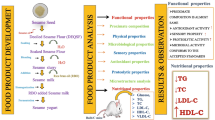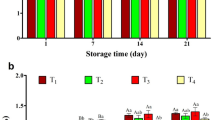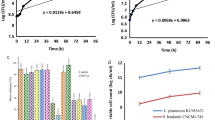Abstract
The aim of this study was to obtain an isoflavone-supplemented soy yogurt, fermented with Enterococcus faecium CRL 183 and Lactobacillus helveticus ssp jugurti, with suitable sensory properties and to assess the effects of the final product on blood lipids in hypercholesterolemic rats. Four isoflavone supplementation procedures were tested, in which the isoflavone was added at these stages: (1) before heat-treatment; (2) after heating and before fermentation; (3) after fermentation and (4) in the okara (by-product of soy milk) flour stirred into the fermented product when consumed. The products were subjected to a test of sensory acceptability. To assess their potential hypocholesterolemic properties in vivo, four groups of rats were used: control (C), hypercholesterolemic (H), hypercholesterolemic plus fermented product (HF) and hypercholesterolemic plus isoflavone-supplemented fermented product (HFI). Hypercholesterolemia was induced in rats of groups H, HF and HFI by feeding them on a commercial rat chow to which cholesterol and cholic acid had been added. Total, HDL and non-HDL cholesterol and triglycerides were measured in the blood of the rats. No significant sensorial differences were detected among the samples of soy yogurt supplemented with isoflavones at various processing stages. Rats fed a fermented soy product enriched with isoflavones (HFI group) had significantly (P < 0.05) less serum total cholesterol (15.5%) compared with rats fed a hypercholesterolemic diet (H group). Non-HDL cholesterol was less (P < 0.05) in rats fed a fermented soy product enriched or not with isoflavones (27.4 and 23.2%) compared to H group. The HDL-C and triglyceride concentrations did not differ significantly among the groups. It was possible to obtain an isoflavone-supplemented soy yogurt with satisfactory sensory characteristics. The resulting supplemented soy yogurt was capable of producing a lipid-lowering effect in hypercholesterolemic rats, relative to the animals that did not consume this product.
Similar content being viewed by others
References
Goff DA, Bertoni AG, Kramer H, Bonds D, Blumenthal RS, Tsai MY, Bruce M, Psaty BM (2006) Circulation 113:647–656
Pearson TA (2002) Circulation 105:886–892
IV Diretriz Brasileira sobre Dislipidemias e Prevenção da Aterosclerose (2007) Arq Bras Cardiol 88:1–48
Basu A, Devaraj S, Jialal I (2006) Arterioscler Thromb Vasc Biol 26:995–1001
Anthony MS, Clarkson TB, Hughes CL, Morgan TM, Burke GL (1996) J Nutr 126:43–50
Kirk EA, Sutherland P, Wang SA, Chait A, LeBoeuf RC (1998) J Nutr 128:954–959
Kudou S, Fleury Y, Welti D, Magnolato D, Uchida T, Kitamura K, Okubo K (1991) Agric Biol Chem 55:2227–2233
Anthony MS, Clarkson TB, Bullock BC, Wagne JD (1997) Arterioscler Thromb Vasc Biol 17:2524–2531
Song T, Lee SO, Murphy PA, Hendrich S (2006) Exp Biol Med 228:1063–1068
Yamakoshi J, Piskula MK, Izumi T, Tobe K, Saito M, Kataoka S, Obata A, Kikuchi M (2000) J Nutr 130:1887–1893
Grunewald KK (1982) J Food Sci 47:2078–2079
Nguyen TDT, Kang JH, Lee J (2007) Food Microbiol 113:358–361
Klaver FAM, Meer R (1993) Appl Environ Microbiol 59:120–124
Rossi EA, Giori GS, Holgado APR, Valdez GF (1994) Microbiol Alim Nutr 12:267–270
Rossi EA, Vendramini RC, Carlos IZ, Pey IC, Valdez GF (1999) Eur Food Res Technol 209:305–307
Rossi EA, Vendramini RC, Carlos IZ, Ueiji IS, Squinzari M, Silva SI, Valdez GF (2000) Arq Bras Cardiol 74:213–216
Rossi EA, Vendramini CR, Carlos IZ, Oliveira MG, Valdez GF (2003) Arch Latinoam Nutr 53:47–51
Rossi EA, Rosier I, Dâmaso AR, Carlos IZ, Vendramini RC, Abdalla DSP, Talarico VH, Minto DF (2004) Alim Nutr 15:93–99
Stone H, Sidel J (1993) Sensory evaluation practices. Academic Press, New York, p 338
Macfie HJH, Bratchell N, Greenhoff K, Vallis LV (1989) J Sens Stud 4:129–148
Allain CA, Poon LS, Chan CSG, Richmond W, Fu PC (1974) Clin Chem 20:470–475
Bergmeyer HW (1974) Methods of enzymatic analysis. Academic Press, London, pp 1890–1893
Fossati P, Prencipe L (1982) Clin Chem 28:2077–2080
Liu J, Sempos C, Donahue RP, Dorn J, Trevisan M, Grundy SM (2005) Diabetes Care 28:1916–1921
SAS I (2000) SAS/Stat user’s guide version 8.8, 2nd edn. SAS Institute, Cary
Gonzales S, Ibarracin G, Locascio R, Pesce Male M, Apella MC, Pesce R, Holgado A, Oliver G (1990) Microbiol Alim Nutr 8:349–354
Nikander E, Tiitinen A, Laitinen K, Tikkanen M, Ylikorkala O (2004) J Clin Endocrinol Metab 89:3567–3572
Dewell A, Hollenbeck CB, Bruce B (2002) J Clin Endocrinol Metab 87:118–121
Dalais FS, Ebeling PR, Kotsopoulos D, McGrath BP, Teede HJ (2003) Clin Endocrinol 58:704–709
Damasceno NRT (2001) Influência das isoflavonas extraídas da soja na hipercolesterolemia e na aterosclerose experimental induzida pela caseína. Faculdade de Ciências Farmacêuticas, USP, São Paulo, p 118
Matsuda S, Norimoto F, Matsumoto Y, Ohba R, Teramoto Y, Ohta N, Ueda S (1992) J Ferment Bioeng 74:301–304
Wang HJ, Murphy PA (1994) J Agric Food Chem 42:1666–1673
Fukutake M, Takahashi M, Ishida K, Kawamura H, Sugimura T, Wakabayashi K (1996) Food Chem Toxicol 34:457–461
Aussenac T, Lacombe S, Dayde J (1998) Am J Clin Nutr 68 (suppl):1480S–485S
Araújo JMA, Carlos JCS, Sedyama CS (1997) Ciênc Technol Alim 17:137–141
Carrão-Panizzi MC, Pinobeléia A, Ferreira S, Oliveira M, Kitamura K (1999) Pesq Agropec Bras 34:1045–1052
Bowles S, Demiate IM (2006) Ciênc Tecnol Alim 26:652–659
Rossi EA (2001) Alimentos funcionais. In: Damaso A (ed) Nutrição e exercícios na prevenção de doenças. MEDSI, Rio de Janeiro, pp 337–362
Zhang X, Shu XO, Gao YT, Yang G, Li H, Jin F, Zheng W (2003) J Nutr 133:2874–2878
Manzoni MJ, Rossi EA, Carlos IZ, Vendramini RC, Duarte ACGO, Dâmaso AR (2005) Nutrition 21:1018–1024
Nestel PJ, Yamashita T, Sasahara T, Pomeroy S, Dart A, Komesaroff P, Owen A, Abbey M (1997) Arterioscler Thromb Vasc Biol 17:3392–3398
Hodgson JM, Puddey IB, Beilin LJ, Mori TA, Croft KD (1998) J Nutr 128:728–732
Crouse JR, Terry JG, Morgan TM, McGill BL, Davis DH, King T, Ellis JE, Burke GL (1998) Circulation 97:816 (abstract)
Cui Y, Blumenthal RS, Flaws JÁ, Whiteman MK, Langenberg P, Bachorik OS, Bush TL (2001) Arch Intern Med 161:1413–1419
Jiang R, Schulze MB, Li T, Rifai N, Stampfer MJ, Rimm EB, Hu FB (2004) Diabetes Care 27:1991–1997
Pischon T, Girman CJ, Sacks FM, Rifai N, Stampfer MJ, Rimm EB (2005) Circulation 112:3375–3383
Teixeira SR, Potter SM, Weigel R, Hannum S, Erdman JW Jr, Hasler CM (2000) Am J Clin Nutr 71:1077–1084
Zhuo XG, Melby MK, Watanabe S (2004) J Nutr 134:2395–2400
Sacks FM, Lichtenstein A, Van Horn L, Harris W, Kris-Etherton P, Winston M (2006) Circulation 113:1034–1044
Teede HJ, Dalais FS, Kotsopoulos D, Liang YL, Davis S, McGraph BP (2001) J Clin Endocrinol Metab 86:3053–3060
Jenkins DJ, Kendall CW, Garsetti M, Rosenberg-Zang RS, Jackson CJ, Agarwal S, Rao AV, Diamands EP, Parker T, Faulkner D, Vuksan V, Vidgen E (2000) Metabolism 49:537–543
Author information
Authors and Affiliations
Corresponding author
Additional information
This work was supported by Fundação de Amparo à Pesquisa do Estado de São Paulo, FAPESP.
Rights and permissions
About this article
Cite this article
Rossi, E.A., Cavallini, D.C.U., Carlos, I.Z. et al. Intake of isoflavone-supplemented soy yogurt fermented with Enterococcus faecium lowers serum total cholesterol and non-HDL cholesterol of hypercholesterolemic rats. Eur Food Res Technol 228, 275–282 (2008). https://doi.org/10.1007/s00217-008-0932-9
Received:
Revised:
Accepted:
Published:
Issue Date:
DOI: https://doi.org/10.1007/s00217-008-0932-9




